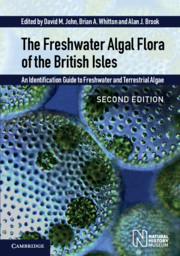 The Freshwater Algal Flora of the British Isles
The Freshwater Algal Flora of the British Isles Book contents
- Frontmatter
- Contents
- The online material (formerly provided in DVD format)
- List of Contributors
- Foreword
- Preface
- Acknowledgements
- Introduction
- Distribution and Ecology
- History of Freshwater Algal Studies in the British Isles
- Field Methods
- Laboratory Methods
- Water Framework Directive
- Cultures of British Freshwater Algae
- Classification
- Key to phyla
- Cyanobacteria (Cyanophyta)
- Phylum Rhodophyta (Red Algae)
- Phylum Euglenophyta (Euglenoids)
- Phylum Cryptophyta (Cryptomonads)
- Phylum Dinophyta (Dinoflagellates)
- Phylum Raphidophyta
- Phylum Haptophyta (Prymnesiophyta)
- Phylum Chrysophyta (Golden Algae)
- Phylum Xanthophyta (Tribophyta) (Yellow-Green Algae)
- Phylum Eustigmatophyta
- Phylum Bacillariophyta (Diatoms)
- Phylum Phaeophyta (Brown Algae)
- Primitive Green Algae (‘PRASINOPHYTA’)
- Phylum Chlorophyta (Green Algae)
- Phylum Glaucophyta
- Glossary
- Standard Form of Authors of Algal Names
- Sources of Illustrations or Material
- References
- Taxonomic Index
- Subject Index
- Plate Saction
- Miscellaneous Endmatter
- Miscellaneous Endmatter
Phylum Cryptophyta (Cryptomonads)
Published online by Cambridge University Press: 12 January 2024
- Frontmatter
- Contents
- The online material (formerly provided in DVD format)
- List of Contributors
- Foreword
- Preface
- Acknowledgements
- Introduction
- Distribution and Ecology
- History of Freshwater Algal Studies in the British Isles
- Field Methods
- Laboratory Methods
- Water Framework Directive
- Cultures of British Freshwater Algae
- Classification
- Key to phyla
- Cyanobacteria (Cyanophyta)
- Phylum Rhodophyta (Red Algae)
- Phylum Euglenophyta (Euglenoids)
- Phylum Cryptophyta (Cryptomonads)
- Phylum Dinophyta (Dinoflagellates)
- Phylum Raphidophyta
- Phylum Haptophyta (Prymnesiophyta)
- Phylum Chrysophyta (Golden Algae)
- Phylum Xanthophyta (Tribophyta) (Yellow-Green Algae)
- Phylum Eustigmatophyta
- Phylum Bacillariophyta (Diatoms)
- Phylum Phaeophyta (Brown Algae)
- Primitive Green Algae (‘PRASINOPHYTA’)
- Phylum Chlorophyta (Green Algae)
- Phylum Glaucophyta
- Glossary
- Standard Form of Authors of Algal Names
- Sources of Illustrations or Material
- References
- Taxonomic Index
- Subject Index
- Plate Saction
- Miscellaneous Endmatter
- Miscellaneous Endmatter
Summary
In spite of being widespread in freshwater habitats, in the British Isles the cryptomonads have been neglected by phycologists and protistologists alike. Most reports in the British freshwater literature consist of simple lists of taxa with no or few illustrations of the specimens.
Cryptomonads are notoriously difficult to identify with certainty from live or preserved natural samples using light microscopy alone. This is due to the scarcity of readily observable taxonomic characters, coupled with a high degree of phenotypic variability. Additionally, in the last 40 years the traditional cryptomonad taxonomy and systematics have been revolutionized by new ultrastructural information (see Novarino, 2003), to the extent that the most recent formal classification schemes are based almost entirely on ultrastructure (Novarino and Lucas, 1993b, 1995; Clay et al., 1999). Electron microscopy is now a routine morphological identification tool (Novarino et al., 1997; Barlow and Kugrens, 2002; Novarino, 2005; Cerino and Zingone, 2006; Xing et al., 2008). Furthermore, an ever-increasing amount of molecular genetic information has become available. Initially the focus was mostly on the phylogeny of the cryptomonads as a whole (Maerz et al., 1992; Douglas and Murphy, 1994; McFadden et al., 1994; Gilson et al., 1995; Liaud et al., 1997; Wang et al., 1997; Van der Auwera et al., 1998; Douglas and Penny, 1999). More recently, molecular sequence data have also been used to investigate the phylogeny of genera and suprageneric groupings. However, the situation is still far from resolved (Cavalier-Smith et al., 1996; Marin et al., 1998; Deane et al., 2002; Hoef-Emden et al., 2002; Shalchian-Tabrizi et al., 2008). Molecular sequencing data are also contributing to understanding relations between species within some genera (Deane et al., 1998; von der Heyden et al., 2004; Hoef-Emden, 2007, 2008; Hoef-Emden and Melkonian, 2003; Lane and Archibald, 2008). For a review of molecular investigations for taxonomic purposes at and below the genus levels, see Cerino and Zingone (2007).
Inevitably, all this overshadows the significance of existing light microscopy-based reports, especially when they lack accompanying information and illustrations. Ideally, reports ought to be based on the totality of features visible by light and electron microscopy, supplemented by molecular sequence data. Unfortunately, such a comprehensive approach to taxonomic identification is difficult to achieve in practice, especially during routine ecological surveys.
- Type
- Chapter
- Information
- The Freshwater Algal Flora of the British IslesAn Identification Guide to Freshwater and Terrestrial Algae, pp. 240 - 249Publisher: Cambridge University PressPrint publication year: 2021


